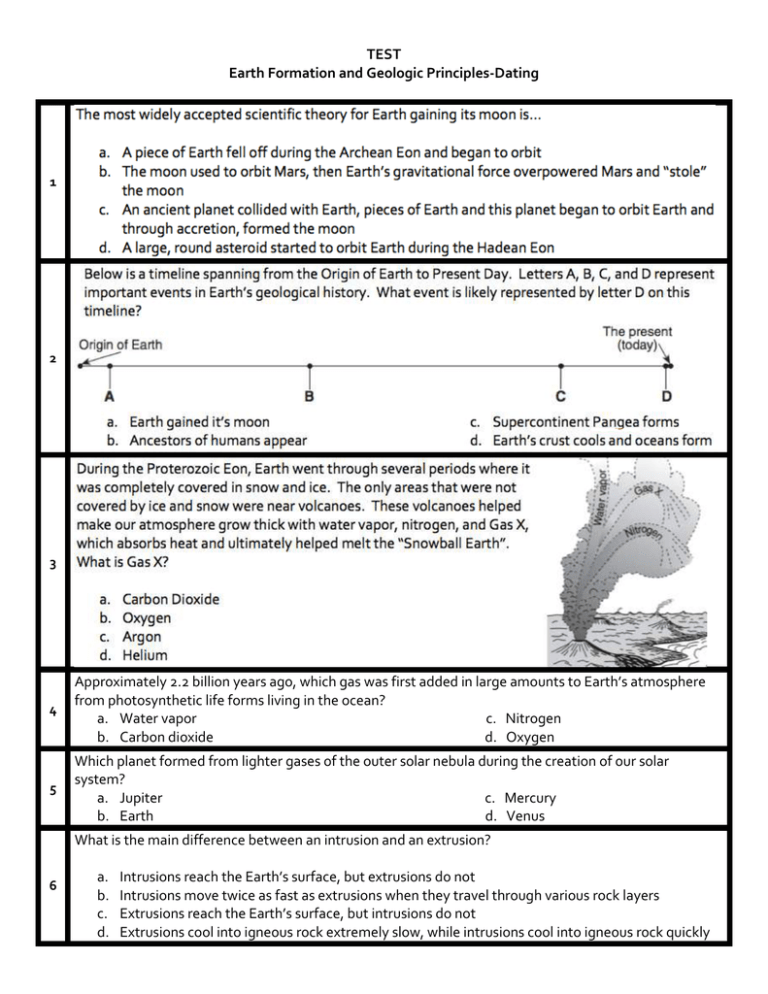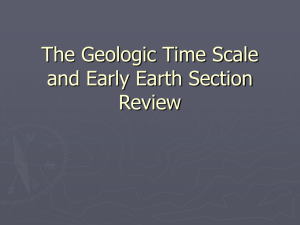Test 2
advertisement

TEST Earth Formation and Geologic Principles-Dating 1 2 3 4 Approximately 2.2 billion years ago, which gas was first added in large amounts to Earth’s atmosphere from photosynthetic life forms living in the ocean? a. Water vapor c. Nitrogen b. Carbon dioxide d. Oxygen 5 Which planet formed from lighter gases of the outer solar nebula during the creation of our solar system? a. Jupiter c. Mercury b. Earth d. Venus What is the main difference between an intrusion and an extrusion? 6 a. b. c. d. Intrusions reach the Earth’s surface, but extrusions do not Intrusions move twice as fast as extrusions when they travel through various rock layers Extrusions reach the Earth’s surface, but intrusions do not Extrusions cool into igneous rock extremely slow, while intrusions cool into igneous rock quickly TEST Earth Formation and Geologic Principles-Dating 7 The most commonly accepted age of Earth is ________________________________. a. 5.6 billion years old c. 4.0 billion years old b. 4.6 billion years old d. 6.0 billion years old 8 Earth has sustained life for billions of years due to the presence of water, oxygen, and various other elements, but there was a time period in Earth’s history when no water was present. Which time period in Earth’s geologic history had an absence of water? a. Archean Eon c. Proterozoic Eon b. Cenozoic Era d. Hadean Eon 9 Which geologic principle states: rocks are deposited in layers that are flat or horizontal. a. Original horizontality c. Uniformitarianism b. Superposition d. Cross-cutting relations Which feature in the rock cross section below is the oldest? Which geologic principle supports the selection you made? 10 a. b. c. d. The oldest feature is Q and is supported by Lateral Continuity The oldest feature is P and is supported by Intrusive Relations The oldest feature is Q and is supported by Superposition The oldest feature is Q and is supported by Uniformitarianism A fault, which is defined as a break or fracture in rock, is always younger than the rock it cuts through, according to which geologic principle? 11 a. Cross-cutting relations c. Superposition b. Lateral continuity d. Fossil succession The table below shows the radioactive decay of carbon-14. Part of the table has been left blank on purpose. After 22,800 years, approximately what percentage of the original carbon-14 remains? 12 a. 50% b. 12.5% c. 6.25% d. 0% In 1785, James Hutton, stated that evidence of past occurrences can be used to explain events which are still happening today. Which of the following could most likely be used to explain an event in the 13 geologic past? a. Sunspots c. Cloud formations b. Erosion d. Solar flares A hillside along a highway has exposed layers of undisturbed sedimentary rock. Which method would be best for scientists to use to determine the relative age of these sedimentary rock layers? 14 a. Calculating the rate of radiometric decay c. Apply the principle of superposition b. Apply the principle of cross-cutting relations d. Calculate the rate of erosion TEST Earth Formation and Geologic Principles-Dating Observe the geologic cross section below. Notice the points in the cross section represent locations where fossils were found. Which of the following best describes the fossil at Point 2 when compared with the fossils are Points 1 and 3? 15 a. b. c. d. The fossil at Point 2 is less common than fossils at Points 1 & 3. The fossil at Point 2 is smaller than the fossils at Points 1 & 3. The fossil at Point 2 is older than the fossils at Points 1 & 3. The fossil at Point 2 is older than the fossil at Point 1 and younger than the fossil found at Point 3. Scientists estimate that if fossils were deposited during a certain time frame, then the entire rock layer was also deposited at the same time. A scientist finds Trophite fossils. According to the chart at the right, in what era and period was this rock layer deposited? 16 a. b. c. d. Mesozoic Era, Triassic Period Mesozoic Era, Jurassic Period Paleozoic Era, Triassic Period Cenozoic Era, Tertiary Period Analyze the graph below CAREFULLY. What is the half-life of the radioactive isotope shown in the graph below? a. b. c. d. 17 125 million years 60 million years 55 million years 50 million years TEST Earth Formation and Geologic Principles-Dating Analyze the graph below CAREFULLY. A fossil sample is taken and is found to have only 40% of the original parent isotope remaining. What is the best estimate of the age of this fossil sample? a. b. c. d. 60 million years old 70 million years old 80 million years old 100 million years old 18 19 Critical Response: Compare and contrast relative and absolute dating. In your response discuss the advantage(s) or disadvantage(s) of both types of geologic dating. 20 Critical Response: Describe the process of accretion and how it relates to the formation of our solar system AND the formation of our moon. Critical Response: Analyze the geologic cross section below. Provide the geologic history of this cross section. Your answer should include: the order in which each feature formed and an example of at least one of the geologic principles we have discussed. 21








